SK Hynix Licenses DBI Ultra Interconnect for Next-Gen 3DS and HBM DRAM
by Anton Shilov on February 11, 2020 5:30 PM EST- Posted in
- Memory
- Nintendo 3DS
- SK Hynix
- HBM
- Interconnect
- HBM2
- HBM3
- DBI Ultra
- Invensas
- Xperi
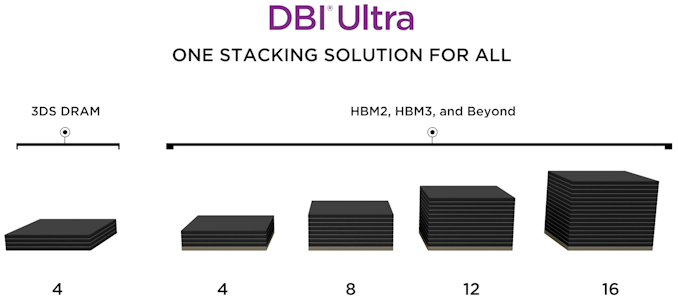
SK Hynix has inked a new broad patent and technology licensing agreement with Xperi Corp. Among other things, the company licensed the DBI Ultra 2.5D/3D interconnect technology developed by Invensas. The latter was designed to enable building up to 16-Hi chip assemblies, including next-generation memory, and highly-integrated SoCs that feature numerous homogeneous layers.
Invensas’ DBI Ultra is a proprietary die-to-wafer hybrid bonding interconnect technology that supports from 100,000 to 1,000,000 interconnects per mm2, using interconnect pitches as small as 1 µm. According to the company, the much greater number of interconnects can offer dramatically increased bandwidth vs. conventional copper pillar interconnect technology, which only goes as high as 625 interconnects per mm2. The small interconnects also offer a shorter z-height, making it possible to build a stacked chip with 16 layers in the same space as conventional 8-Hi chips, allowing for greater memory densities.
Just like other next-generation interconnect technologies, DBI Ultra supports both 2.5D and 3D integration. Furthermore, it allows integration of semiconductor devices of different sizes and produced using different process technologies. Such flexibility will be particularly useful not only for next-generation high-capacity high-bandwidth memory solutions (including 3DS, HBM, and beyond), but for various highly-integrated CPUs, GPUs, ASICs, FPGAs, and SoCs.
DBI Ultra uses a chemical bond that allows for interconnect layers that add no stand-off height, and require no copper pillars or underfill. While the process flow used for DBI Ultra is different when compared to conventional stacking processes, it continues to involve known good dies and does not require high temperatures, which results in relatively high yields.
All of this does come at a cost, however, and that's something that Invensas keeps to itself. The firm does not disclose how much DBI Ultra costs to use, or how that compares to the technologies used today.
SK Hynix does not disclose how it plans to use the DBI Ultra technology, though it is reasonable to expect the DRAM producer to use the new capability for next-generation memory products.
Craig Mitchell, president of Invensas, said the following:
“As the industry increasingly looks beyond conventional node scaling and turns toward hybrid bonding, Invensas stands as a pioneering leader that continues to deliver improved performance, power, and functionality, while also reducing the cost of semiconductors. We are proud to partner with SK hynix to further develop and commercialize our DBI Ultra technology and look forward to a wide range of memory solutions that leverage the benefits of this revolutionary technology platform.”
Related Reading:
- SK Hynix Announces 3.6 Gbps HBM2E Memory For 2020: 1.8 TB/sec For Next-Gen Accelerators
- JEDEC Updates HBM2 Memory Standard To 3.2 Gbps; Samsung's Flashbolt Memory Nears Production
- Samsung Develops 12-Layer 3D TSV DRAM: Up to 24 GB HBM2
- Samsung HBM2E ‘Flashbolt’ Memory for GPUs: 16 GB Per Stack, 3.2 Gbps
- SK Hynix: Customers Willing to Pay 2.5 Times More for HBM2 Memory
Source: Xperi


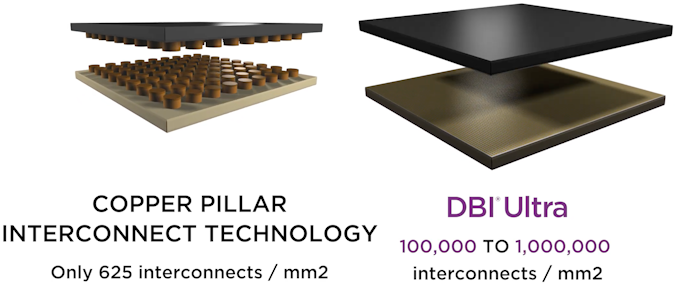
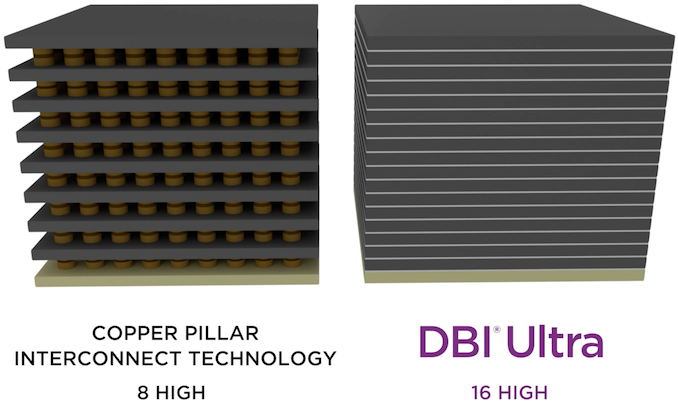
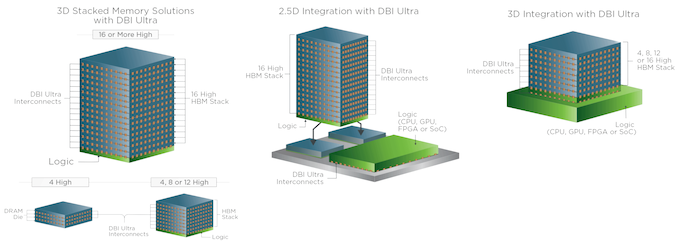
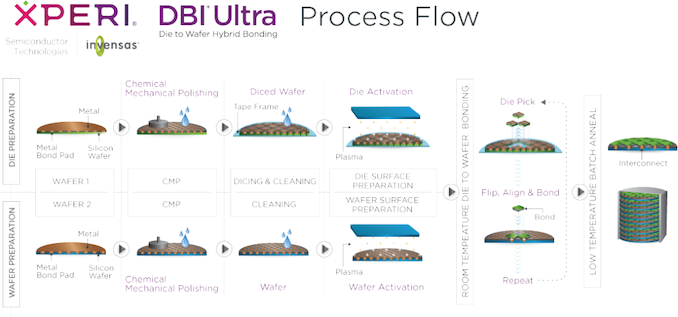
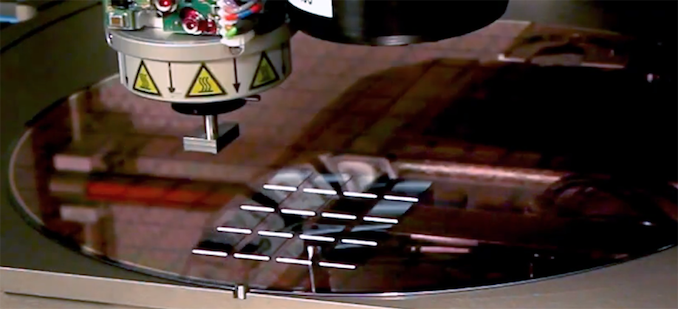








9 Comments
View All Comments
nandnandnand - Tuesday, February 11, 2020 - link
16+ layers is exciting to be sure, but it sounds like the interconnect density is a bigger deal. What magnitude of improvements will that bring?lightningz71 - Wednesday, February 12, 2020 - link
In the areas that this is being looked at, one of the current biggest roadblocks to performance is the technology to allow enough individual electrical paths between devices. Given how small current lithography is, IC packages are needlessly large for many of them for the single purpose of allowing more area for connection pins. Being able to scale the density of connections from the current ~625/mm-sq to "100,000+" / mm-sq can give a 1000 fold increase in connections. Now, because you're dealing with larger stacks, that's going to be spread across many more individual devices, but, say you quadruple the height of the stack in number of units, that 1000x increase in connection density still easily allows 10-100X the bandwidth between devices at current per pin data rates. Conveniently, devices largely can't use that magnitude of data rate increase at present; there's just not enough processing power to sustain that level of throughput in most cases. Instead, you can reduce the data rate by a factor of ten, which requires SUBSTANTIALLY less power. So, cutting the data rate by a factor of ten, but increasing the number of channels by a factor of 100-1000 still nets you 10-100X the data throughput at a potentially significant power savings. And, all of this can be accomplished with even smaller packages because of the crazy high pin density. This means less used package material, and that you can pack more of them on individual devices.nandnandnand - Thursday, February 13, 2020 - link
I like this answer. Thanks.Averant - Wednesday, February 12, 2020 - link
Well, consider: Traditional copper pillar interconnects are what... 600-ish per square mm. This technology is promising 100,000 - 1,000,000 per square mm. More interconnects means more throughput and higher bandwidth. With all things being equal(which we don't have the information to confirm) we're taking several orders of magnitude in performance.nandnandnand - Thursday, February 13, 2020 - link
Or a couple of orders of magnitude at reduced power consumption.Hopefully we will see at least 4-8 GB of HBM being stacked on all CPUs (Zen 4?), GPUs, and APUs. And then 3DSoC for the ultimate performance gains.
Santoval - Wednesday, February 12, 2020 - link
"All of this does come at a cost, however, and that's something that Invensas keeps to itself. The firm does not disclose how much DBI Ultra costs to use, or how that compares to the technologies used today."Confidential licensing terms (particularly licensing fees) are always suspect. One can assume that DBI Ultra costs much more than the competition, and secret licensing fees allow the company to ask for different money on a case by case basis. But why make that secret though? They could always negotiate openly.
Larger volume of devices = less money does not need to be secret. Is the cost of DBI Ultra so much higher than "copper pillar" that they are afraid of scaring off the interested parties? Wouldn't the under the table secret negotiations scare off more clients though?
valinor89 - Wednesday, February 12, 2020 - link
I actually read that as they have not disclose the actual cost difference between the old method and the new one. A part from licensing costs the most important would be what it actually cost to use it on a product. Does it need new machines and lenghty or fiddly proceses?SaberKOG91 - Wednesday, February 12, 2020 - link
Doesn't really matter. SK can afford it and it will get used across all of their memory product lines.carcakes - Sunday, February 23, 2020 - link
It could have like 8GB HBM2 memory versus triple socket 7 TB ddr4 memory